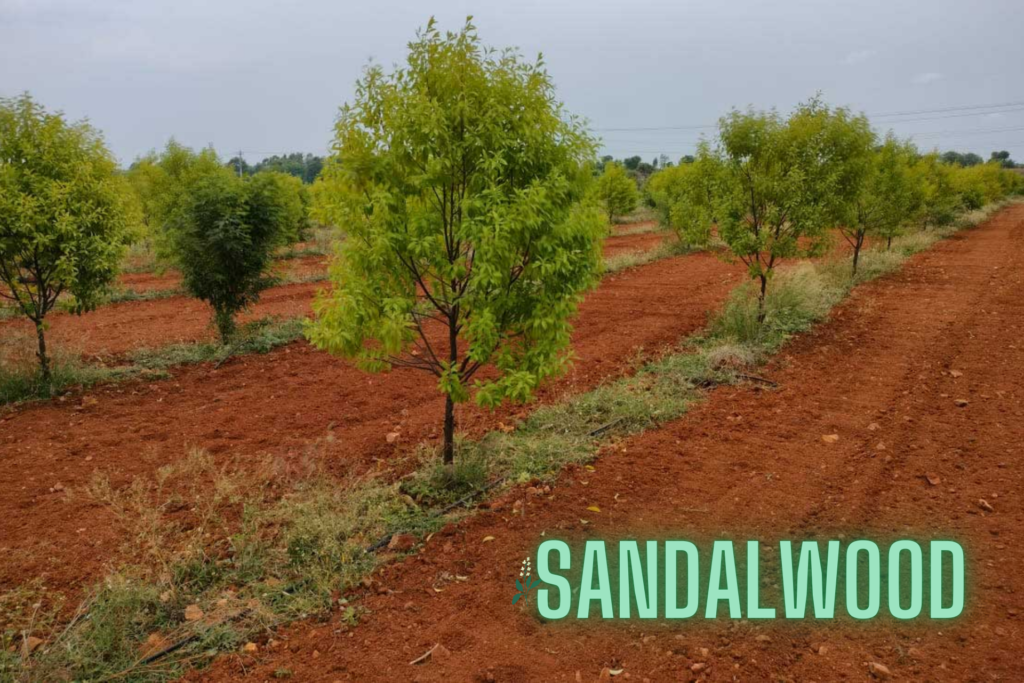Sandalwood is one of the most valued and popular trees in the world. Sandalwood is prized for its Spiritual Importance, Medical Qualities, and Fragrant Wood. Sandalwood Plantations are frequently viewed as a long-term potential to earn wealth by farmers and investors searching for profitable agriculture projects. If you want to know about Managed Farmlands Benefits Check out our Blog.

Before beginning a sandalwood plantation, however, a crucial question comes up:
Which is better for farming, red sandalwood or white sandalwood?
Each variety offers Unique Benefits, Growth Needs, and Market Value. We shall discuss the following topics in this blog:
- The differences between white and red sandalwood
- The best conditions for sandalwood plantations
- Profitability and consumer demand
- A comprehensive guide for establishing a plantation
By the end, you’ll be able to identify the sandalwood variety that best fits your plantation requirements.
1.What is White & Red Sandalwood?
White Sandalwood (Santalum Album)
- Known by its scientific name, Santalum Album.
- It is native to India, Indonesia, and Australia.
- It is highly prized in Cosmetics, Ayurveda, and Spiritual Ceremonies.
- It requires host plants for growth.
Red Sandalwood (Pterocarpus Santalinus)
- It is primarily found in Southern India.
- It is used in Medicine and Woodworking, but it has no scent.
- It is highly prized in traditional medicine and furniture building.
- It grows on its own without the help of host plants.
Red sandalwood is utilized for wood-related and medicinal purposes, whereas white sandalwood is mostly used for its essential oil and smell.
2.Growth Conditions & Plantation Requirements
Understanding Soil Conditions, Temperature, and Maintenance needs are essential when selecting a sandalwood variety for a plantation.
| Factor | White Sandalwood | Red Sandalwood |
| Climate | Tropical & subtropical | Semi-arid & tropical |
| Soil | Well-drained, loamy | Rocky, lateritic soils |
| Watering | Moderate | Low |
| Growth Speed | 12-15 years to mature | 20-25 years to mature |
| Requires Host Plants? | Yes (Neem, Acacia) | No |
3.Profitability & Market Demand

White Sandalwood:
- It is highly sought after in both domestic and foreign markets.
- It is costly, costing between ₹10,000 and ₹25,000 per kilogram.
- Permits are needed for growing and harvesting.
Red Sandalwood:
- Well-liked in China, Japan, and the Middle East.
- Costs between ₹1,500 and ₹5,000 per kilogram.
- Less regulated than white sandalwood.
4.Steps to Start a Sandalwood Plantation
Step 1: Select the Right Land
- White Sandalwood requires a humid tropical climate.
- Red Sandalwood can grow in rocky regions.
- Both require well-drained soil and adequate sunlight.
Step 2: Get Government Permissions
- White Sandalwood: Requires the Forest Department’s approval.
- Red Sandalwood: Less restrictive, however local permissions can be required.
Step 3: Buy Quality Saplings
- Buy Certified Sandalwood Saplings from Licensed Suppliers or government nurseries.
Step 4: Planting & Maintenance
- White Sandalwood: Neem and acacia are required as host plants.
- During the first three years, water often.
- Keep pests and unauthorized cutting at bay.
Wrapping Up:
Which One Should You Choose?
- White Sandalwood is a good choice if you want to make a lot of money quickly, can get government clearances, and are ready to invest in maintenance.
- If you want a long-term, low-maintenance investment with few restrictions from the government and are prepared to wait longer for returns, go for Red Sandalwood.
